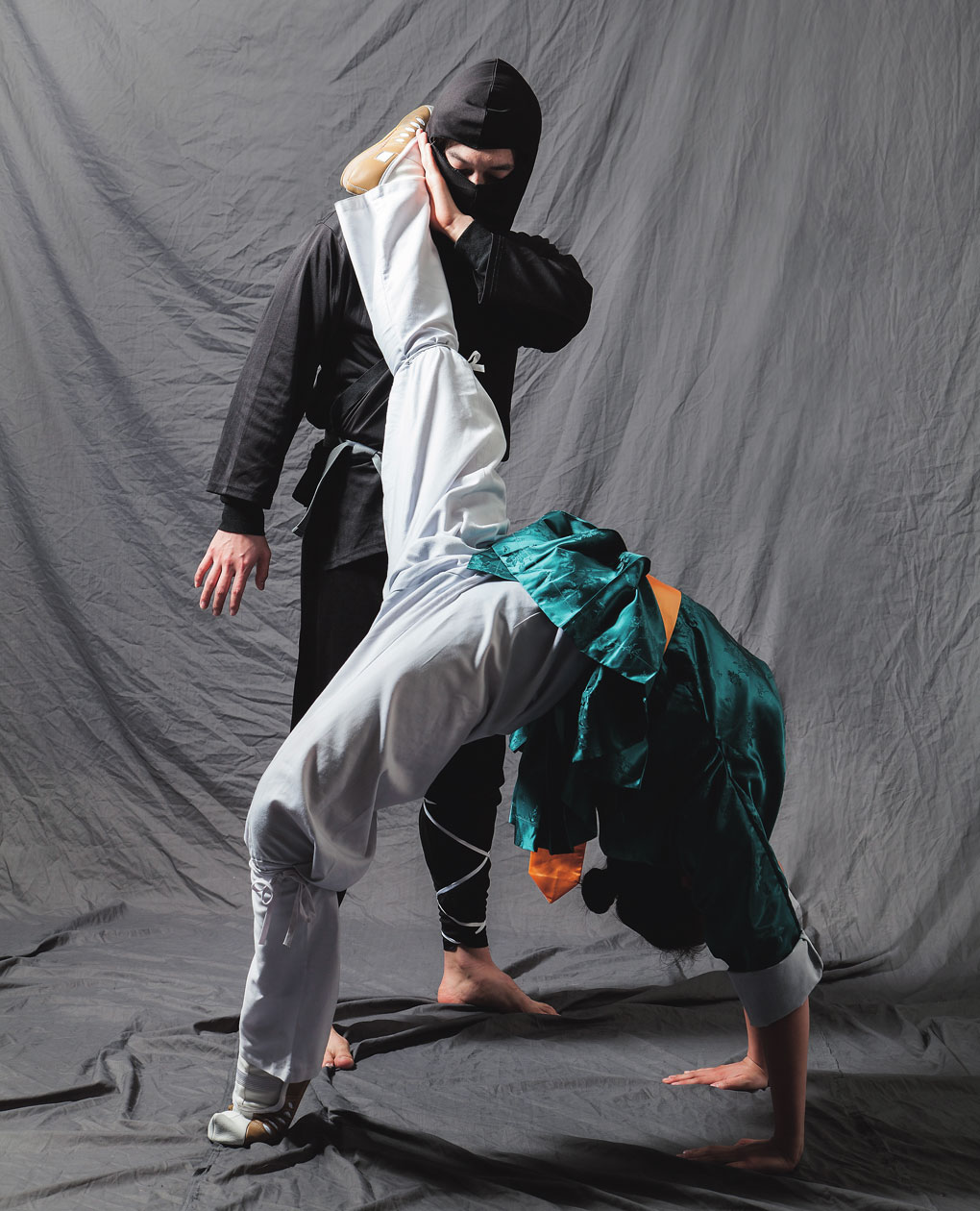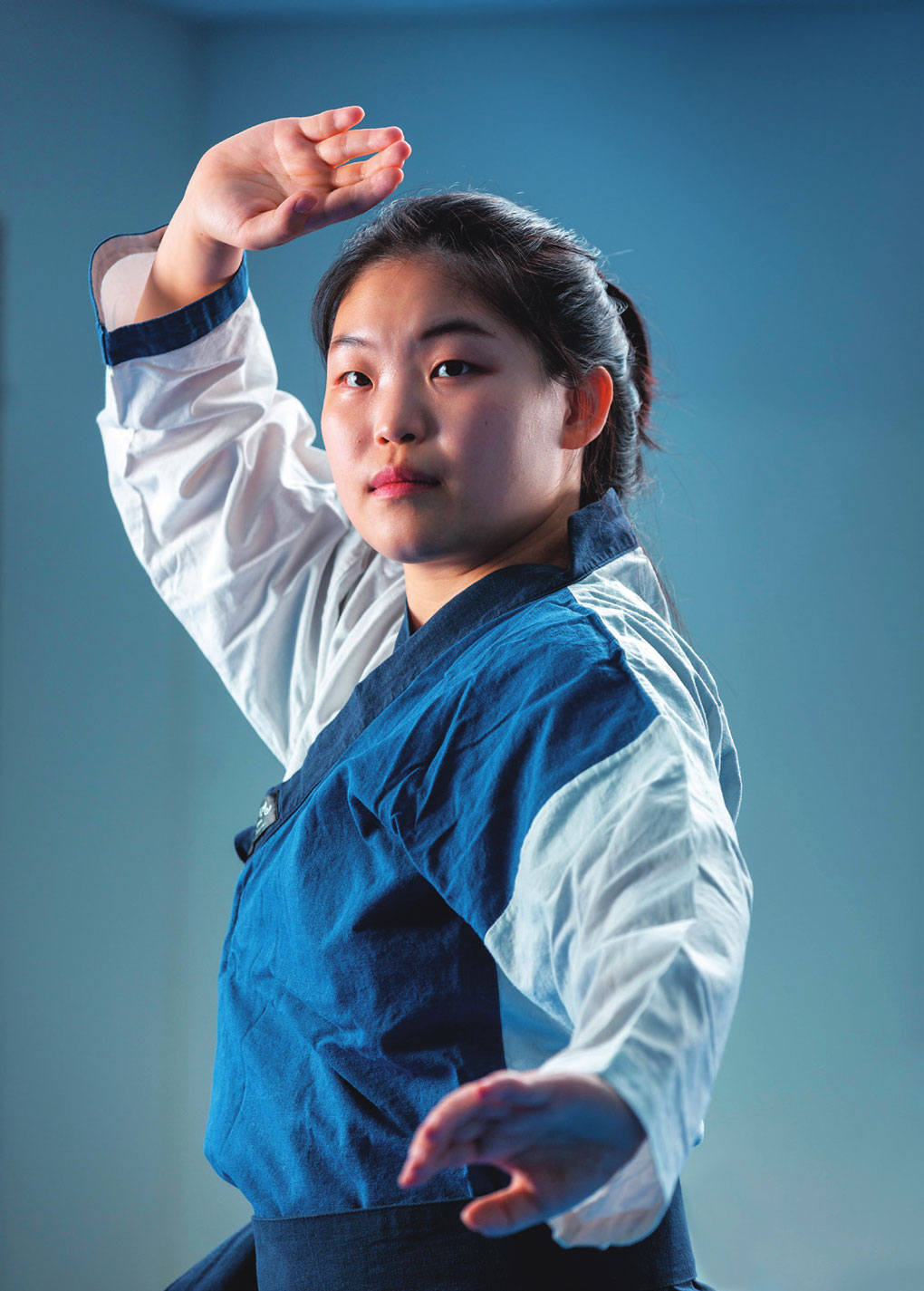Park Shin-young has practiced the traditional Korean martial art taekkyeon for almost 25 of her 29 years. Today, the young master uses her skills and experience to operate a social enterprise that produces stage performances, spreading the spirit of harmony and goodwill at home and abroad.
Afaded photograph more than a century old would determine the course of a young girl’s life. Park Shin-young was still too young to attend the kindergarten run by her parents when they brought in a martial arts instructor one day to start a daily class for children. She joined the class and, without even knowing what she was learning, instantly fell in love with it.
“It didn’t feel like I was learning something, but rather that I was dancing and playing as much as I liked. I looked forward to the class every day,” Park recalled.
This is how Park was introduced to taekkyeon, a traditional Korean martial art which she has now practiced for nearly a quarter century. Just as she sensed as a child, taekkyeon does indeed look like dance, with its fluid, constantly changing movements. This is what mainly distinguishes it from taekwondo, a more widely-known Korean martial art with a similar name.
The old photograph, capturing a taekkyeon match between two little boys encircled by young spectators, was presumably taken by a Western missionary sometime during the final years of the Joseon Dynasty (1392-1910). In pre-modern Korea, taekkyeon matches were a regular feature of village events. The locals were divided into upper and lower village teams, with the most skilled contestants selected from each area to compete. Usually, children’s matches were held first. “Much later, I learned that my parents had come across that old photo of children playing taekkyeon somewhere,” Park elaborated. “They thought it would help children with self-discipline and self-protection.”

Park Shin-young, representative of IK Taekkyon, shows off a variation of the side kick called gyeot chigi, which has earned her the grand prize in several competitions. © IK Taekkyon
Village Events
Taekkyeon, also spelled taekkyon or taekyon, is a combative sport in which the hands and feet are used to strike or take down an opponent. As its other names, subakhui (literally “hand-fighting play”) and gakhui (“feet play”), suggest, taekkyeon actually began as a festive game for outdoor events. Like many other folk traditions, its origins are not clearly recorded in literature. But its long history can be traced back to similar movements depicted on a sparring mural in Muyongchong (Tomb of the Dancers), dating to the Goguryeo Kingdom (37 B.C.-A.D. 668). Taekkyeon is listed among both the Republic of Korea’s Important Intangible Cultural Heritage and UNESCO’s Intangible Cultural Heritage of Humanity.
Taekkyeon looks like dance mostly because of pumbapgi, a set of basic foot motions that beginners learn at the start. The footwork s a dance-like impression, especially when combined with big, circular arm movements called hwalgaetjit.

Lee Ju-young, Park’s husband and instructor (left), and Ahn Hyung-soo, deputy representative of IK Taekkyon, perform a side kick while jumping in the air.
“Dominating without hurting is hard to do, but makes you truly powerful. It’s a state that’s impossible to reach without mental discipline.”
Fluid Movements

Park demonstrates hand movements. Taekkyeon’s hand attack techniques are as diverse as its foot movements and powerful, despite looking rather mild.
The footwork is rather simple and easy to learn – stepping one foot in front of the other and rhythmically bending the knees, then withdrawing the foot while leaning back nimbly at the waist. The rhythmic motion adds speed and versatility to the footwork, and the limber waist provides impetus.
However, easy to learn does not necessarily mean easy to master. As Park explained, “You can figure out how skilled a practitioner is just by looking at their foot movements. A novice tends to be impatient, moving hastily, whereas advanced practitioners are relaxed. The three-beat rhythm isn’t the same from one performer to another, either. A skilled performer nicely balances one stressed step followed by two unstressed ones, or two unstressed steps followed by one stressed step. These graceful foot movements can abruptly turn into kicks or are combined with grabs to take an opponent down. If you fail to read the rhythm, you’ll be helpless and get knocked down in an instant.”
Probably due to the dance-like motions and unfamiliar shouts of “Eek-eh!” or “Ack-eh!” often mimicked by comedians, taekkyeon is sometimes seen as a comedic sport. But in fact, it’s an actively practiced martial art with considerable destructive power. As two fighters encounter each other at arm’s length, all sorts of foot attacks can be made with few preliminary motions.
Fighters can choose from an array of kicks, including a front kick delivered with the top of the foot (jegyeo chagi), a roundhouse kick similar to the hard blow of a club (huryeo chagi), a hook kick delivered with the top of the foot to the opponent’s side (gyeot chigi), and an upside-down kick performed by pivoting in the air while standing on one’s hands (nal chigi). There is no predicting which kick will be applied when. Park Shin-young’s main skill is gyeot chigi, which has earned her grand prizes at a number of prestigious contests, including the National Sports Festival.
Soft Outside, Strong Inside
Just like ssireum (traditional Korean wrestling) and judo, taekkyeon also incorporates impressive techniques for tripping, throwing and striking an opponent. Elegant movements aside, taekkyeon’s perfect synchronization of defensive and offensive techniques makes it a highly combative sport. At its core, however, is respect for the value of life and common prosperity. In most other martial arts, power means forcefully taking control and relentlessly dominating the opponent, giving them no chance to fight back. In contrast, taekkyeon always allows both parties equal opportunities, as implied by the way the footwork is performed with one leg within the opponent’s attacking range. This basic posture is called daejeop, meaning “hospitable treatment.” In other words, the opponent is more of a guest to be courteously welcomed than an enemy to be destroyed.
To win without hurting the opponent is one of the major goals of taekkyeon. Perhaps it is the nature of all competitions to instigate rivalry, and contestants may end up inflicting inadvertent damage on each other. But in a taekkyeon match, harming an opponent is considered a violation of the rule of mutual goodwill and leads to a loss. That’s why practitioners should train themselves mentally and physically in equal measure; the hands and feet of a fighter with brilliant technique but no self-possession can easily turn into brutal weapons.
“You might find it easy to harm others with force, and people might say you’re powerful. But that’s not power – it’s brutality. Dominating without hurting is hard to do, but makes you truly powerful. It’s a state that’s impossible to reach without mental discipline,” Park said.
For some time, Park was also swayed by a desire to get stronger, visiting one training studio after another to meet eminent masters. She hoped to imbibe their secret techniques and make them her own. Then one day, it dawned on her that she had been seeking technical skills alone, with no regard for spirit. It was a sobering moment. She stopped her quest for strength and launched a social enterprise, IK Taekkyon, with her fellow members of the Korea Taekkyon Federation who had worked together as a demonstration team.
Social Enterprise
Six years have passed since Park launched the enterprise. In that time, she has visited numerous foreign countries to demonstrate taekkyeon and produced stage performances adopting the formats of performing arts genres such as traditional outdoor theater (madanggeuk) and musicals. “Nothing makes me as happy and energized as practicing taekkyeon, which for me is both work and rest at the same time,” she said. “I still have a long way to go, and I know I have to work harder because there are still people who ask me what taekkyeon is.”
Kim Dong-okFreelance Writer
Ahn Hong-beomPhotographer